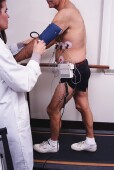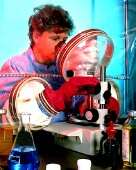Home > Weekly Newsletters > Diet & Fitness
September 15, 2008
More Sweat Equals Lower Risk of Exercise-Induced Asthma
MONDAY, Sept. 8 (HealthDay News) -- The more an athlete sweats, the lower the risk of exercise-induced asthma, a new study suggests.
"The same mechanism that makes you sweat controls airway secretion," explained study author Dr. Warren Lockette, head of clinical investigation at the Naval Medical Center, in San Diego.
His report was published in the September issue of Chest.
This latest study follows other research, just published in The Journal of Allergy and Clinical Immunology, that found obese people with asthma likely to have worse control and quality of life than non-obese patients with asthma.
Lockette's team looked at the fluid secretion rates of 56 athletes suspected of having exercise-induced asthma, which can accompany a diagnosis of asthma or exist by itself, only when exercising. Symptoms include shortness of breath, wheezing and coughing.
Lockette analyzed the secretion rates of the athletes' sweat, saliva and tears. They measured air movement through the lungs, called forced expiratory volume (FEV), before and after giving the athletes methacholine, a drug which can cause airways to constrict in asthma patients.
They measured response to pilocarpine, a substance used to induce sweating and saliva production.
Those most sensitive to methacholine, shown by the greatest fall in FEV, were least sensitive to the pilocarpine. In other words, the more hyperactive the airway, the less the sweat production.
The average sweating rates of those who didn't respond to the methacholine were higher -- and they didn't have asthma.
"The same thing that controls how well you sweat controls how well you control airway secretion," Lockette said. "If you are sweating through your skin, you have sweaty airways, meaning you are putting out a lot of fluid, which keeps airways from getting dry. The dryness triggers the asthma."
They also correlated a lower risk of exercise-induced asthma with how much the athletes teared up and salivated. "You may stink, drool or cry, but at least you won't gasp," he joked.
The practical applications are yet to be determined, he said, but perhaps increasing secretions in some way may reduce asthma episodes.
The possibility that exercise-induced asthma is related to sweat secretions doesn't surprise Dr. Clifford Bassett, an assistant clinical professor of medicine at the Long Island College Hospital, SUNY-HSCB, Brooklyn, and clinical instructor of medicine, New York University School of Medicine, who serves as vice chairman of the public education committee for the American Academy of Allergy, Asthma & Immunology.
He added that exercise-induced asthma doesn't rule out activity. "The positive spin is, you can still engage in exercise, even on a high level," he said.
Educate yourself, he advised. Know that exercising in cold air is usually worse than warm air, for instance. The condition is typically treated with bronchodilators, with exact instructions best coming for your allergist or other physician.
More information
To learn more about exercise-induced asthma, visit the American Academy of Allergy, Asthma & Immunology
.
Antioxidant-Rich Diet May Protect Against Eye Disease
FRIDAY, Aug. 29 (HealthDay News) -- Eating plenty of antioxidant-rich food such as blueberries, artichokes and pecans may help protect against macular degeneration, the leading cause of age-related blindness in the United States and other developed countries.
U.S. researchers found that antioxidants disrupt a link between two processes in the retina that, in combination, contribute to macular degeneration. Antioxidants also extend the lifetime of irreplaceable photoreceptors and other retinal cells.
The "destructive synergy" that causes macular degeneration occurs when a buildup of a compound called A2E disrupts energy production in mitochondria, the "power plants" in cells, the researchers said. The lack of energy interferes with daily cleaning and maintenance of photoreceptors and another type of retinal cell. This leads to more buildup of A2E and a continuing cycle that results in the destruction of the vital visual cells that can't be replaced.
Experiments using visual cells from humans, rats and cows showed that antioxidants could completely counter the damage caused by this process, said the researchers from Brigham Young University and Weill Medical College of Cornell University.
"The implication is that people at risk of macular degeneration could help prevent the disease by consuming antioxidants," study author Heidi Vollmer-Snarr, a Brigham Young chemist, said in a university news release.
The study was published online in the Journal of Biological Chemistry.
"This work by Dr. Vollmer-Snarr and colleagues ties these two damaging processes together and demonstrates the harm they cause in combination is much more than would be expected," Dr. Paul Bernstein, of the University of Utah's Moran Eye Center, said in the news release. "This new knowledge," added Bernstein, who wasn't involved in the study, "suggests the possibility of interventions which could prove to be powerful ways to prevent or delay age-related macular degeneration."
More information
The U.S. National Eye Institute has more about age-related macular degeneration.
Treadmill Workouts Help Stroke Survivors
THURSDAY, Aug. 28 (HealthDay News) -- Working out on a treadmill improves brain function and fitness for people who have survived a stroke and gone through the usual rehabilitation program, a new study found.
"You address two problems these patients have," said study researcher Dr. Andreas Luft, a professor of clinical neurology and neurorehabilitation at the University of Zurich in Switzerland. "One is that they don't know how to walk. Not walking, they become deconditioned and lose cardiovascular fitness. With the treadmill type of training, you improve walking and also increase fitness."
Luft worked with physicians at Johns Hopkins University, the University of Maryland and the Baltimore Veterans Affairs Medical Center on the study. It compared the brain and physical function of 37 people who had had strokes and worked on a treadmill three times a week, with 34 people who were given traditional stretching exercises.
After six months, peak walking velocity increased by 51 percent in the treadmill group and just 11 percent in the stretching group. Cardiovascular fitness increased by 18 percent with the treadmill routine, but decreased by 3 percent in the group limited to stretching.
And magnetic resonance imaging showed an increase of blood flow carrying more oxygen to the brainstem and cerebellum for those who worked on the treadmill.
"The most important clinical aspect of the study is that it is saying recovery can occur long after a stroke and can occur even after all the routine therapies have been tried," said Dr. Daniel Hanley, professor of neurology at Johns Hopkins. "Scientifically, the most important point appears to be that rewiring of the brain may be involved in this process, not just body conditioning."
The average age of study participants was 63, and the average time they began the treadmill program was 50 months after the stroke, Hanley noted.
"The average stroke patient now has about eight physical therapy sessions over six to 12 weeks," Hanley said.
The study, published in the Aug. 29 issue of the journal Stroke, shows that treadmill work "should be part of standard treatment for every stroke survivor who has a walking habit," Luft said.
That may not be an easily achievable goal, Luft acknowledged. "Most physical therapy departments have treadmills, but they don't use them to the extent that we used them in the study," he said.
And stroke survivors can't just climb on a treadmill and start walking, Luft said. "Because this is exhausting, it should always be done under supervision," he said. "There is always the risk of running into heart problems and falling. We used special treadmills with handrails and also monitored the heart rate to achieve the level of exertion we needed."
Nevertheless, Hanley said, "the study defies current practice."
More information
Learn more about stroke rehabilitation from the National Institute of Neurological Disorders and Stroke.
Calcium Might Have Taste Humans Can Detect
WEDNESDAY, Aug. 20 (HealthDay News) -- It may be time to add calcium to the types of tastes -- sweet, sour, salty, bitter and savory -- that can be detected by humans, according to U.S. researchers.
They found that a taste for calcium exists in mice. Since mice and humans share many of the same genes, the finding suggests that people may also be able to taste calcium. If that's true, it could have a number of implications.
"People don't consume as much calcium as nutritionists would like, and one reason for this is that foods high in calcium don't taste good to many people. Tweaking its taste could encourage a calcium-deficient population to consume more of this key nutrient," Michael G. Tordoff, of the Monell Chemical Senses Center in Philadelphia, said in an American Chemical Society news release.
"By understanding how calcium is detected in the mouth, we can either make it easier to consume by reducing its bad taste or even make pharmacological agents that make it taste better," Tordoff said.
He and his colleagues identified two receptors on the tongues of mice that are involved in tasting calcium. One is a calcium-sensing receptor called CaSR that has been found in the parathyroid gland, kidney, brain and gastrointestinal tract.
"We didn't know it was on the tongue before," Tordoff said.
The other receptor is T1R3, which plays a role in sweet taste. The discovery that T1R3 also plays a role in tasting calcium was "very unexpected."
Tordoff and his team were expected to presented the research Wednesday at the American Chemical Society's national meeting, in Philadelphia.
More information
The Society for Neuroscience has more about taste.



